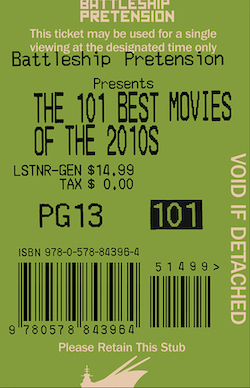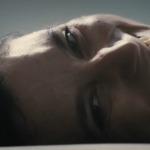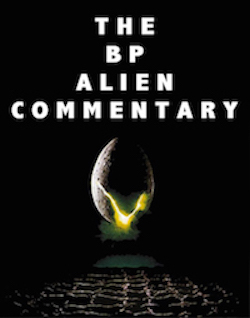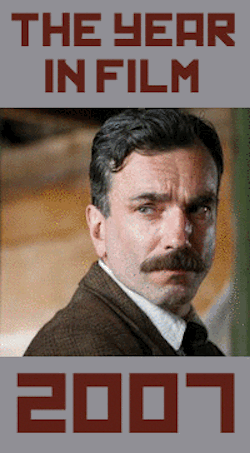Monday Movie: Scarlet Street, by Tyler Smith
Every Monday, we’ll recommend a movie–it could be a classic, an overlooked recent treasure, an unfairly maligned personal favorite or whatever the hell we feel like–and we’ll tell you where to find it online.
Ah, film noir. The genre that looks at the American Dream and scoffs. Characters in a good film noir are often deeply flawed, but their desires are really no different than those of the rest of us. In any other film, the story would be about said characters overcoming their flaws while achieving their goals. No such luck here. In film noir, a character’s flaws eventually entrap him, leaving him grasping desperately as his dreams slowly float away.
While film noir is a decidedly American genre, it is worth noting that some of the best filmmakers to tackle it are from somewhere else. Often, these filmmakers migrated to America from Europe in the midst of World War II. And perhaps that is why it works so well. Perhaps the best way to view the intangibility of the American Dream is through the lens of war torn fatalism. While some in America were thrilled to have both the Great Depression and World War II behind them, others couldn’t shake the horrors that they witnessed. The mobs, the death camps, the mass graves. Many American filmmakers excelled at capturing the darker side of our nature, but somehow it seemed like the German directors- so deeply aware of how quickly a country can lose its humanity- were uniquely positioned to create a cinematic world of existential despair.
One such director is Fritz Lang. Known for the German classics Metropolis and M, Lang immigrated to Hollywood and put his own stamp on mainstream American filmmaking. His Expressionistic style fit perfectly into such films as Fury and The Big Heat. Perhaps most notably, though, is the deeply disturbing Scarlet Street.
In many ways, Scarlet Street is a standard film noir. We have a well meaning protagonist brought into a world of deception and intrigue by a sultry woman, only to have his life turned upside down. In the basic structure of the film, there is nothing very unusual about the proceedings. But it’s when we look at the specific details- the character quirks, the misanthropy, the brutal violence- that we see what sets this film apart.
Perhaps the first thing we notice is that our main character is not at all what we would assume him to be. Played by reliable Hollywood tough guy Edward G. Robinson, our protagonist- a bank cashier named Chris Cross- is actually a fairly pathetic individual. He is reserved, sheepish, and henpecked to his core. To see Robinson in such a role is immediately unnerving. How could Rico from Little Caesar be wearing a floral apron as he does the dishes?
One night, our mild mannered hero happens across a young woman being beat up by a thug. Chris goes to alert a police officer. When they get back, the thug is gone and the young woman, named Kitty, expresses her gratitude for Chris’s chivalry. Chris walks Kitty home and, along the way, discusses his hobby of painting. Kitty misunderstands and takes him for a professional painter. Not wanting to tell this beautiful woman that is, in fact, only a cashier, Chris allows her to believe that he is an accomplished artist.
And, with that little white lie, our hero’s fate is sealed.
Turns out that the thug that Chris scared off is actually Kitty’s boyfriend, Johnny. He beats up on her from time to time, but that doesn’t stop her from loving him. When she tells him about Chris, the two work together to scam some money off of what they think is a rich, successful painter. Chris, not wanting to disappoint Kitty, takes full advantage of his trusted position at the bank to secure some funds. And Chris just finds himself drawn deeper and deeper into criminal activity, all because he falls in love with very much the wrong girl.
Most film noir succeeds due to a stable of interesting characters. Double Indemnity, The Maltese Falcon, Touch of Evil, Out of the Past; they all feature quirky and dangerous personalities clashing in pursuit of their own desires. Scarlet Street is no exception and, in fact, manages to up the ante. Where many of the villains in these films are sleek and extremely capable, the antagonists here display a desperation that enables them to justify any immoral behavior. While I’m a sucker for Kasper Gutman and Joel Cairo, they operate merely out of greed, whereas Kitty and Johnny act out of necessity. They are not people of means, so they do everything they can to eke out what passes for a living. Like cornered animals, they lash out in all directions, making victims out of everybody they come into contact with.
While Joan Bennett deserves a great deal of credit for crafting a genuinely infuriating femme fatale, the real scene stealer is Dan Duryea as Johnny. Few things get under my skin more than a smiling monster, and Johnny spends most of the film grinning from ear to ear. A small time hood with big aspirations, Johnny clearly tries to look and act the part of the affable gentleman, lazily bantering with Kitty and Chris. But he can change on a whim, brutally smacking Kitty in the face the moment she says something he doesn’t like. Between the two of them, we get a villainous team that is not only evil, but truly screwed up. The way Bennett flutters her eyes at Johnny, even after receiving a swift slap in the face, is both frustrating and vulnerable. How can a woman be so in love with an animal like that?
It is Fritz Lang’s willingness to make us ask uncomfortable questions like this that makes Scarlet Street a cut above your average film noir. And while we may assume that Chris’s story could possibly have a happy ending, we need only look at the world these characters inhabit to know that it’s just not going to happen. Chris has been brought into a world of shadows and paranoia. Nobody is what they seem, everybody is in it only for themselves, and, once you’re in, there’s no getting out. It is probably one of the most cynical films I have ever seen.
Scarlet Street is available on Amazon Prime.






























